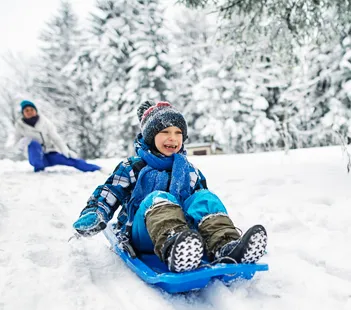January 01, 2017

Sledding Safety
Sledding down a snowy hill has long been a favorite winter activity. While the bumpy ride can be thrilling, it can also be dangerous. Every year thousands of people are injured sledding in parks, streets and recreational areas. Most of these injuries are preventable.
In many ways, sledding is more dangerous than skiing or snowboarding. These sports are typically performed in groomed areas where there's wide, open terrain and are monitored by trained safety officers. Sledding hills don’t usually have the same precautions in place. There may be trees, rocks, and other hazards that can easily throw a child off balance. On site medical personnel and adult supervision are usually nonexistent. The very nature of sledding on a device that lacks basic safety features – like a restraint system and the ability to steer – creates additional concerns.
In a recent study in the United States, it was found that more than an estimated 230,000 children and teens age 19 and younger were treated for sledding injuries in emergency departments between 1997 and 2007 (Journal of Pediatrics). This is an alarming number for an activity you can only do a couple days each year.
Common Injuries:
- Fractures 26%
- Bruises/abrasions 25%
- Cuts 16%
- Sprains 16%
The head is the most frequently harmed body part; more than 9% kids hurt sledding sustained traumatic brain injuries. Children under the age of 6 who were injured while sledding had three times the number of head injuries, compared to teenagers and adults (Center on Injury Research and Policy at Nationwide Children’s Hospital in Columbus, Ohio).
- 10-14 year olds account for the most injuries 42.5 %
- 5-9 year olds 29.5%
- 60% of injuries are to boys.
Safety Tips
- Wear the appropriate equipment. Insist that your child wear a helmet, preferably a ski or snowboarding helmet, to protect their heads. Have your child to wear gloves, hats, boots, and warm clothing to protect against frostbite.
- Only sled in open areas. Choose a sledding area clear of obstacles. The most common cause of injury (contributing to 50% of injuries) was collision, which usually occurred when kids slid into fixed objects like trees, poles or benches. The majority of injuries occur at the end of the sledding path.
- Have adult supervision. Adults need to make sure children sledding down a hill don't collide with others or into a hazardous area like trees, rocks, parking lots, or ponds or frozen water.
- Avoid streets and highways. Sledding on streets accounts for about 2 percent of all injuries, but the kids hurt in those kinds of accidents are more likely to suffer serious head injuries or require hospitalization because they slide into the path of moving cars.
- Use common sense. Nearly 6,000 kids were hurt while being pulled on a sled behind a vehicle, including cars, trucks, snowmobiles, ATVs and lawnmowers.
- Sled when you can see. Avoid sledding during snowstorms, at night or where there in inadequate lighting to avoid collisions and accidents.
- Always supervise your children when sledding. Adult supervision can help avoid overcrowding and collisions.
- Choose a sled with a steering mechanism. Being able to steer can help you or your child avoid a collision. The sled should have runners and a steering mechanism, which is safer than toboggans or snow disks.
- Sit facing forward. Make sure your child always sits facing forward. No one should sled headfirst. All participants should sit in a forward-facing position, steering with their feet or a rope tied to the steering handles of the sled.
Download Snow Sledding Safety Tips PDF
Sources: American Academy of Orthopaedic Surgeons; Center on Injury Research and Policy at Nationwide Children’s Hospital in Columbus, Ohio; Safe Kids; Consumer Product Safety Commission
© 2012 Denver Health

